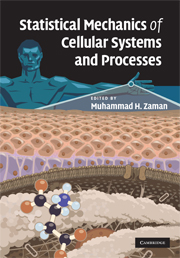Book contents
- Frontmatter
- Contents
- List of contributors
- Preface
- 1 Concentration and crowding effects on protein stability from a coarse-grained model
- 2 Observations on the mechanics of a molecular bond under force
- 3 Statistical thermodynamics of cell–matrix interactions
- 4 Potential landscape theory of cellular networks
- 5 Modeling gene regulatory networks for cell fate specification
- 6 Structural and dynamical properties of cellular and regulatory networks
- 7 Statistical mechanics of the immune response to vaccines
- Index
- Plate section
3 - Statistical thermodynamics of cell–matrix interactions
Published online by Cambridge University Press: 04 September 2009
- Frontmatter
- Contents
- List of contributors
- Preface
- 1 Concentration and crowding effects on protein stability from a coarse-grained model
- 2 Observations on the mechanics of a molecular bond under force
- 3 Statistical thermodynamics of cell–matrix interactions
- 4 Potential landscape theory of cellular networks
- 5 Modeling gene regulatory networks for cell fate specification
- 6 Structural and dynamical properties of cellular and regulatory networks
- 7 Statistical mechanics of the immune response to vaccines
- Index
- Plate section
Summary
Introduction
Cells live, interact, and proliferate in a highly rich, diverse, and complex extracellular environment. Interactions with this dynamic extracellular environment occur through both signaling and adhesion receptors on the cell surface [1]. These receptors, which are typically transmembrane, are also responsible for regulating and modifying the cellular environment, just as the environment regulates the cell structure and function [2, 3]. In this chapter, we will focus primarily on the extracellular domain of the cell-adhesion receptors. This domain interacts with a variety of soluble and insoluble extracellular ligands. While these receptors are not limited to mechanical interaction and are essential for signaling, we will focus primarily on the physical and mechanical interactions between receptors and ligands with a discussion on implications for signaling presented in the final part of this chapter.
Mechano-chemical interactions of cell adhesion receptors play a phenomenal role in cellular function in both healthy and diseased cell state [4–6]. These receptors are responsible for adhesion, detachment and motility of a vast number of cells in vivo (Fig. 3.1). These processes are necessary for proper cell function, survival, and proliferation. At the same time, extracellular matrix not only affects this interaction, but also interacts directly with the cells through a number of adhesion receptors. Up- or downregulation of these receptors has been associated with increased invasion rates in a number of cancers with high incidence-to-death ratio [6].
- Type
- Chapter
- Information
- Statistical Mechanics of Cellular Systems and Processes , pp. 54 - 73Publisher: Cambridge University PressPrint publication year: 2009



